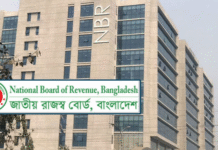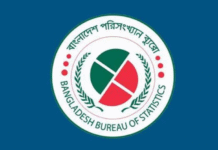
The year 2020 could have been a watershed for Bangladesh. Policymakers would have put their heads together and looked at what have been achieved and what went wrong in order to set targets accordingly to become a prosperous and developed nation.
But people had to spend the entire year fighting against the deadly virus to keep their heads above water as the pandemic headwinds have brought the whole world to its knees.
Amid distress and devastation everywhere, businesses were in a testing situation that they had not experienced at least in the last two decades.
It was kind of an endurance test for the economy, and so far, it appeared to be a winner, despite bruises.
“Endurance is the call of the day. And we are doing that,” said Ahsan H Mansur, executive director of the Policy Research Institute of Bangladesh.
In fact, Bangladesh’s economy grew the highest in Asia and the third-highest in the world in 2020, when only 23 out of 190 economies managed to post positive growth, according to the International Monetary Fund.
“Growth is not a major concern during situations like this. Managing to survive is the most important thing,” said Zahid Hussain, a former lead economist of the World Bank’s Dhaka office.
The battle against the pandemic showed the real character of Bangladeshi people, businesses and the economy.
The farmers defying the threat of catching the virus and fatal consequences continue to feed the nation, dispelling worries of a food crisis and allowing the government to focus on healing the economy and the health sector.
Migrant workers soldiered on and sent even higher amount of dollars, saving families and the economy.
As a result, remittance is breaking records months after months, so are foreign currency reserves. The macroeconomic stability is broadly intact, according to Mansur.
Inflation is high but is not at an intolerable level yet.
A significant achievement is the installation of the last span of Padma Bridge, which will connect both sides of the mighty Padma river.
Bangladesh is also set to surpass India in terms of per capita gross domestic product (GDP) in 2020 thanks to robust agriculture production, exports and remittance.
The biggest winners are the mobile financial services and the e-commerce sector during the pandemic. The embracing of digital solutions in life and work would take the country closer to Digital Bangladesh.
In view of Bangladesh’s glorious graduation from the grouping of the least-developed countries in 2024, the government is working to retain the duty-free market access in export markets.
On December 6, it signed the preferential market agreement with Bhutan. This is the first such agreement with a trading partner.
Since March, the government has unveiled 21 stimulus packages involving more than Tk 120,000 crore, which is about 4.5 per cent of the GDP of Bangladesh and one of the largest in the world.
In April, the government brought down the interest rate to a single digit, in a relief for the entrepreneurs.
Another important development was the passage of the Company Act to allow a single individual to set up a company.
On the downside, the pandemic wiped out the gains Bangladesh made over the past decade on poverty reduction. The poverty level at least returned to the level of 2000, when about 40 per cent of the population living below the poverty line.
Latest data on poverty is not available, but the country might have made some recovery thanks to the restoration of incomes and jobs.
The revenue situation is the weakest part of the economy, and it was not in good shape even before the pandemic as expected reforms did not materialise. The situation exacerbated after the pandemic. As a result, there is pressure on the fiscal space.
“The government is now paying the price. The government has also increased its current expenditure significantly in the last several years,” said Mansur.
Asif Ibrahim, an entrepreneur, said: “The pandemic got everybody in a panic mode, and we were expecting the worst.”
“However, the prudent policy measures put in place by the government in close consultation with the private sector helped the large and export-oriented industries. As a result, the damage was not as bad as expected.”
He said the capital market fell to one of its historic lows. The market has now rebounded.
The securities commission has taken some measures. As a result, the confidence of the investors is coming back gradually, said Ibrahim, also the chairman of the Chattogram Stock Exchange.
Mansur of the PRI said the country was still standing but was not doing well either.
“All of the sectors of the economy have been affected negatively, and they are still in the negative territory.”
The economy is not expected to return to the higher growth territory until the second of 2021.
The 9 per cent lending rate might have given some cushion to the borrowers, but depositors are in trouble as they mostly have a negative return on their investment as banks are flushed with cash because of lower credit demand.
The investment will not make a breakthrough if the economic outlook does not improve.
“This challenge will not go easily and may last until the end of 2021,” Mansur said.
One missing thing in the overall scenario is reform, according to Mansur.
“Reforms are not a matter of a single year. At least, there should be the design of the reforms. The government must show a sincere commitment in case of reforms.”
“The Bangladesh Investment Development Authority is trying to improve the business climate but the government, as a whole, is not moving that fast. A single ministry or body can’t do it.”
Zahid Hussain said, unlike past disasters, corruption and mismanagement in the health sector and the social protection sector did not take a backseat during the pandemic, and this is an unfortunate episode.
He said a sustained recovery in the global economy would take place. “The question is when.”
Bangladesh would have to prepare itself to capitalise on the rebound of the global economy.
“We have to put in place the right infrastructure and build the capability of institutions. We have to bring in dynamism to structural reforms. Then we will be ready to be reconnected with the booming global economy.”
In order to sustain the recovery, the policy interventions that have been tried did not work as expected.
“Policy interventions have to be based on science and evidence and free of corruption and mismanagement to allow the economy to boom when the pandemic comes under control.”









